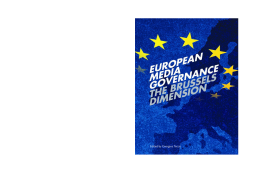
Additional Information
Book Details
Abstract
Media Governance today is shifting media rules and regulations from national government policies to local, regional, national, multinational and international ones and away from exclusively governmental domains to others, such as market, professional and public interest/pressure groups. Many media-related civil society organisations are based in Brussels, operate at a European level and influence exactly the part of Media Governance that has escaped the national shackles of the member states. But which are those organizations and who do they represent? Which are the relevant EU regulations for the different media industries that they try to influence? How do they participate in the media related debates in the different EU institutions? What are their major position papers? What is the current state of affairs in the European Media Governance relevant to their industry and what are the future issues that they are trying to tackle early enough at a European level? Finally, how are their lobbying efforts coordinated with other political, professional and public interest groups? This book presents the work of 10 of these European organizations from a variety of media sectors, as well as the relevant work of the European Commission, the European Parliament, and the European Consumers Association.
Table of Contents
| Section Title | Page | Action | Price |
|---|---|---|---|
| Front Cover\r | FC | ||
| Preliminary Pages\r | 1 | ||
| Contents\r | 7 | ||
| Foreword - European Journalism Centre: 1992-2007\r | 9 | ||
| Editor's Preface\r | 11 | ||
| Introduction\r | 13 | ||
| EU Institutions\r | 25 | ||
| European Media Governance and the Role of the European Commission\r | 27 | ||
| The European Union's Media Policy: The Role of the European Parliament\r | 43 | ||
| Broadcasting\r | 53 | ||
| European Broadcasting Union\r | 55 | ||
| European Media Governance and the Private Radio Industry\r | 67 | ||
| Film | 75 | ||
| Film Directors and European Media Governance\r | 77 | ||
| 87 | |||
| European Media Governance and the Newspaper Industry\r | 89 | ||
| European Media Governance and the Magazine Industry\r | 99 | ||
| Books and the European Union, Mutual Understanding?\r | 109 | ||
| Advertising\r | 119 | ||
| The Digital Revolution - What Does It Mean For Advertising?\r | 121 | ||
| Advertising, the Audio-visual Industry and European Media Governance\r | 129 | ||
| Journalism & Scriptwriting\r | 139 | ||
| European Journalists Press Case for Media Rights for All\r | 141 | ||
| Screenwriters and European Media Governance\r | 151 | ||
| Consumers\r | 171 | ||
| Television Without Frontiers - Advertising Without Limits\r | 173 | ||
| Conclusions: Media Policy of the European Union - Trends and Developments\r | 181 | ||
| Annex A - Inventory of EU Measures Affecting the Media\r | 191 | ||
| Back Cover\r | BC |
